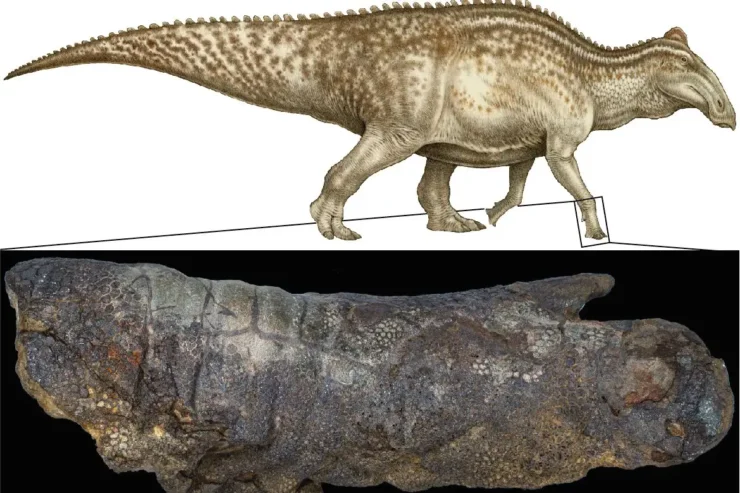The discovery of a particularly well-preserved duck-billed hadrosaur in North Dakota raises the possibility that there are more mummified dinosaur than previously thought.
First, let’s talk about the definition of mummified dinosaur. Focus an Edmontosaurus fossil found in 1999 in North Dakota. About 67 million years ago, the Dakota was a duck-billed dinosaur about 12 meters long that ate plants. Today, the Dakota’s fossilized limbs and tail still contain large areas of well-preserved, fossilized scaly skin. A striking example of mummified dinosaur. The creature is not a real mummy because its skin has turned into rock instead of being preserved as real skin. Researchers began to call such fossils with perfectly preserved skin and other soft tissues mummies.
Now, back to the duck-billed hadrosaur. A 70 million year old dinosaur’s skin has been preserved with gashes, indicating that it was partially eaten by crocodile-like carnivores and possibly other creatures, which may explain why it became mummified.
According to the news of New Scientist, the estimated 7 meter long duck-billed hadrosaur likely lost a lot of the bodily fluids and gases that encourage deterioration.
Clint Boyd from the North Dakota Geological Survey in Bismarck contacted Stephanie Drumheller-Horton at the University of Tennessee in Knoxville, a palaeontologist with expertise in crocodile bites, to look into the mummified remains of an Edmontosaurus dinosaur discovered in the Hell Creek Formation of southwest North Dakota. (Edmontosaurus belongs to the Hadrosauridae family.)
The fossil, which had numerous punctures and gashes in the forelimb and tail, was remarkably well-preserved. According to her, the arc-shaped pattern of wounds and scrapes on the bones and flesh of the arm and hand were very certainly caused by something with crocodile-like teeth latching onto the hadrosaur. A much larger carnivore, perhaps a young Tyrannosaurus rex, could have made a series of longer, V-shaped gashes in the skin, especially around the once-meaty tail.



“Certainly whatever it was, the damage on the tail was physically larger than whatever was working on the arm,” says Drumheller-Horton. “So we think we have at least two different animals involved, and potentially more.”
Attacks likely emptied the corpse in a way that slows decay, a characteristic that has been observed in forensic examination of contemporary specimens. “So instead of all of that stuff sticking around inside the body, keeping it wet, pushing that decomposition along, it’s now out of the way,” says Drumheller-Horton. “It’s basically hollowed out and able to dry out, and what you have left behind is skin and bones.”
Even so, injury marks in soft tissue, like skin, don’t necessarily hold their original shape, which makes it more difficult to identify what happened, she says. The research team does’nt know if the hadrosaur was assaulted by predators prior to its demise, by scavengers following its demise, or by both.
According to Drumheller-Horton, the data refute the idea that dinosaur mummies only happen in rare instances of extremely quick burial or abrupt drying. Additionally, they argue that mummification is more common than previously believed since many partly eaten dinosaurs dried out before being buried beneath layers of sediment.
It is more likely that when researchers come across thin, delicate mummified dinosaur skin, they either mistake it for a simple imprint, or they never see it because it is accidentally destroyed as the fossil is removed from the sediment.
Cover Photo: Illustration of the Edmontosaurus dinosaur and photograph of the preserved forelimb. Full color Edmontosaurus reconstruction by Natee Puttapipat.

A person essentially help to make severely articles I’d state. This is the first time I frequented your web page and so far? I surprised with the analysis you made to create this actual put up amazing. Wonderful job!
Helpful information. Fortunate me I found your web site by accident, and I’m shocked why this coincidence did not came about in advance! I bookmarked it.